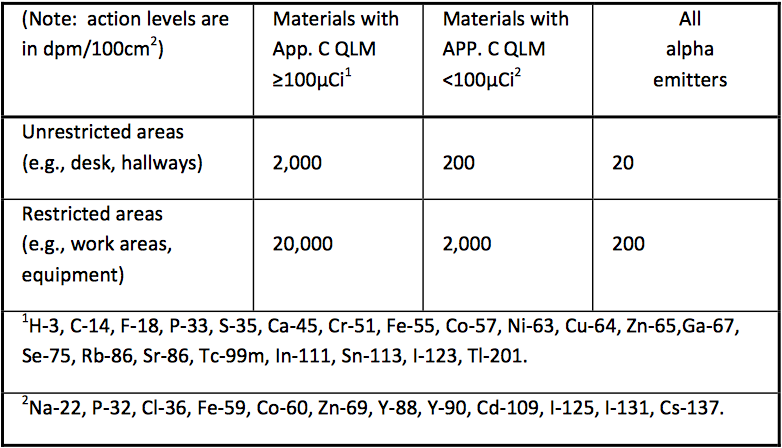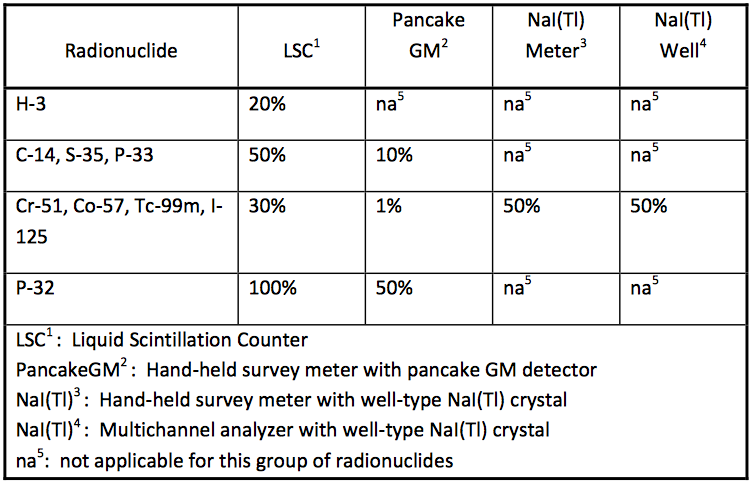The purpose of a physical survey is to identify potential problems, such as poor storage or handling practices, before they actually pose a hazard, and to demonstrate that contamination levels and dose rates are well below limits. Surveys should be done the first week of each month to assure they are not inadvertently omitted, and must be done after each use in shared work areas.
Removable contamination surveys
Removable contamination surveys help identify areas where radioactivity has been spilled. Countertops, sinks, floors, refrigerators, centrifuges, fume hoods, and telephone handsets should all be considered for inclusion. Take a sample by making a 100 cm long wipe of the surface with a small piece of paper towel or a filter paper. Count the sample on the same equipment used to count your experimental samples. This is normally done on a Liquid Scintillation Counter.

Instrument surveys
Appropriate instrument surveys (e.g., GM for high energy betas, NaI(Tl) for low energy gammas) help identify areas where radioactivity has been spilled or where it is inadequately shielded. Survey bench surfaces, your hands, clothing, and shoes. Most researchers use a survey instrument with a speaker, which responds more quickly than the meter needle movement. Perform a “battery check,” and use either a radioactive check source or a known radiation area to confirm the instrument is working before you begin. Move the detector slowly to allow the instrument time to respond.
Action Level
If you find occasionally occupied areas with a penetrating dose rate greater than 2 millirem per hour, or continuously occupied work areas with a penetrating dose rate action level greater than 0.2 millirem per hour, corrective action is required. Consult with the PI or Health Physics.
Records
Health Physics will supply a survey form that includes a room sketch. See example in Forms. Each survey record must include:
- A sketch of the lab,
- Locations of sample points,
- Measurements in mrem/hr or dpm/100cm2,
- Identification of the instrumentation used,
- Background and efficiency in the instrumentation,
- Surveyor’s name, and
- Date
If the instrument (liquid scintillation counter) does not calculate and print dpm, but rather prints just cpm, you must determine the counting efficiency to ensure the counts per minute rate is below the cleanup threshold in Table 3.3 in dpm/100cm2. Typical counting efficiencies are noted in Table 3.4. Document surveys by completing user survey forms and enter into the Sweeps Program, https://radsurvey.stanford.edu. These surveys must be performed and entered into the Sweeps Program the first week of the month.
Building and equipment repair
Before any potentially contaminated areas or equipment, such as a glove box, hood, refrigerator, sink, or pipeline is turned over for repair, it must be surveyed. Call Health Physics. The equipment will be surveyed, de‐labeled, and marked “Cleared for repair or release to uncontrolled area.”
Equipment disposal
Notify Health Physics prior to disposal of any radiation device. Special precautions are needed, and the state may require notification.
TABLE 3.3 ACTION LEVELS FOR REMOVABLE CONTAMINATION. This table provides threshold values that require corrective action if exceeded. Action levels are in dpm, not cpm. See Table 3.4. Call Health Physics if removable contamination is more than ten times the action level in unrestricted areas.

TABLE 3.4 APPROXIMATE DETECTION EFFICIENCIES FOR SOME COMMON RADIONUCLIDES AND DETECTORS. This table provides the approximate detection efficiency for the common radionuclide measurement methods. Multiply the action level from Table 3.3 by the detection efficiency to calculate the instrument cpm that indicates need for corrective action.
